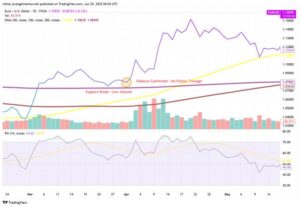The U.S. stock market continues to ride high, with the S&P 500 and the Dow Jones Industrial Average both up by 0.7% over the past week, and the Nasdaq Composite rising by nearly 1%. Investors are digesting several positive economic signals, including cooling inflation and resilient growth data. However, as the market approaches record highs, the spotlight is shifting to a key economic indicator: the September jobs report. The upcoming report is expected to shed light on how quickly the U.S. labor market is cooling, and its implications could have a significant impact on the market in the weeks to come.
Labor Market in Focus
One of the critical aspects of the U.S. economy is the labor market, and the September jobs report will play a crucial role in shaping market sentiment moving forward. Over the past year, the Federal Reserve has implemented a series of aggressive interest rate hikes aimed at controlling inflation. Now, with inflation gradually cooling and moving closer to the Fed's target of 2%, attention is turning to the labor market and how it might influence future rate cuts.
Federal Reserve Chairman Jerome Powell has emphasized that the labor market remains in “solid condition” despite some signs of weakening. He pointed out that the central bank is carefully monitoring the employment situation to determine the timing of future monetary policy decisions, which may include further rate cuts to support economic growth. However, the job market is showing clear signs of cooling. In 2024, the U.S. unemployment rate has crept up steadily and currently sits at 4.2%, close to its highest level in nearly three years.
Additionally, job gains have slowed significantly. In the first half of 2024, the U.S. economy saw its lowest monthly job additions, with fewer positions being added compared to the same period in previous years. In August, the U.S. added just 142,000 jobs, while job openings in July hit their lowest point since January 2021. This decline in labor demand is raising concerns about how quickly the labor market is weakening.
For September, Wall Street consensus estimates indicate that the U.S. economy is expected to have added 130,000 nonfarm payroll jobs, with the unemployment rate likely remaining steady at 4.2%. While these figures reflect a gradual cooling of the labor market rather than a rapid slowdown, they suggest that the economy is entering a period of slower job growth, which may influence the Federal Reserve’s future policy actions.
Why the Jobs Report Matters
The jobs report is a key indicator for investors because it provides crucial information on the health of the U.S. economy and the potential trajectory of Federal Reserve policies. A stronger-than-expected report could suggest that the economy is more resilient than anticipated, potentially delaying any future rate cuts. On the other hand, weaker numbers could signal that the labor market is cooling faster than expected, raising concerns about a potential economic slowdown and increasing the likelihood of further easing by the Fed.
As of now, weekly jobless claims data is showing some positive signs for the economy. The most recent data on jobless claims, released just ahead of the September jobs report, showed claims had dropped to a four-month low. This indicates that layoffs remain low and that despite the slowdown in hiring, employers are holding on to their workers. According to Bank of America U.S. economist Aditya Bhave, the low layoff numbers suggest that the September employment report will be “decent.” Bhave also pointed out that layoffs are a critical metric to watch, as they are one of the key indicators of economic health. As long as layoffs stay low, the base case for the economy will likely remain a “soft landing,” where inflation cools without triggering a significant recession.
Broader Market Implications
Beyond the jobs report, investors are also keeping an eye on other important economic data. Updates on job openings, activity in the services and manufacturing sectors, and consumer confidence are all expected in the coming weeks. These indicators will provide further clarity on the direction of the U.S. economy and how much momentum it can sustain heading into 2025.
Moreover, the upcoming earnings season is drawing attention, particularly with notable updates from major companies like Tesla and Nike. Tesla’s vehicle delivery numbers and Nike’s quarterly earnings results could offer insights into consumer demand, supply chain stability, and how companies are navigating the current economic environment. As corporate results roll in, they will help shape investor sentiment around the health of different sectors in the U.S. economy.
What to Expect Moving Forward
For forex traders and investors, the upcoming jobs report and broader labor market data will be key to understanding where the U.S. economy is headed next. The strength or weakness of the labor market could determine the Fed’s path forward, influencing interest rates and currency values.
If the September jobs report shows stronger-than-expected job growth or lower unemployment, it could put downward pressure on the U.S. dollar as investors anticipate the Fed will hold off on rate cuts. Conversely, a weaker report could spark more concerns about economic slowdown, boosting the likelihood of rate cuts and potentially driving up demand for safe-haven assets like the U.S. dollar and government bonds.
In summary, as the U.S. economy continues to evolve, the September jobs report and other upcoming economic data will provide critical insights into the health of the labor market and the Federal Reserve’s future policy direction. With stock markets near record highs, traders should be prepared for potential volatility depending on the results of this crucial economic indicator. Investors are advised to stay informed, monitor the data closely, and adjust their strategies accordingly as more information comes to light.





